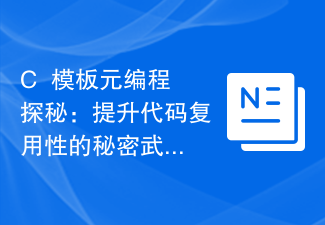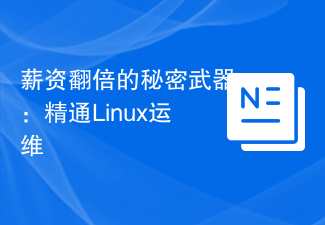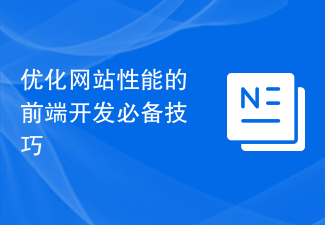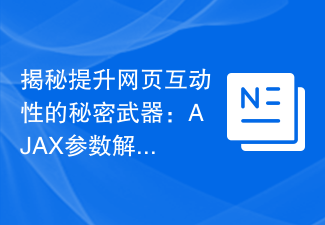
Guava cache usage tutorial: The secret weapon to improve program efficiency
Guava cache is an efficient caching library in Java that can help you significantly improve the performance of your program. It provides multiple caching strategies, such as LRU (least recently used) and LFU (least frequently used), as well as multiple cache loading methods, such as local loading and remote loading.
Basic usage of cache
Using Guava cache is very simple and only requires a few lines of code. First, you need to create a cache instance. You can use the following code to create an LRU cache with a maximum capacity of 100:
LoadingCache<Key, Value> cache = CacheBuilder.newBuilder()
.maximumSize(100)
.build(new CacheLoader<Key, Value>() {
@Override
public Value load(Key key) throws Exception {
// 从数据库或其他数据源加载数据
return loadFromDataSource(key);
}
});Then, you can use the cache to store and retrieve data. You can use the following code to store data into the cache:
cache.put(key, value);
You can also use the following code to get data from the cache:
Value value = cache.get(key);
If the data does not exist in the cache, ## will be called #CacheLoader.load()Method loads data from the data source.
CacheBuilder class, including maximum capacity, expiration time, eviction policy, etc. For example, you can use the following code to create an LRU cache with a maximum capacity of 100 and an expiration time of 10 minutes:
LoadingCache<Key, Value> cache = CacheBuilder.newBuilder()
.maximumSize(100)
.expireAfterWrite(10, TimeUnit.MINUTES)
.build(new CacheLoader<Key, Value>() {
@Override
public Value load(Key key) throws Exception {
// 从数据库或其他数据源加载数据
return loadFromDataSource(key);
}
}); You can also configure the cache eviction policy through the CacheBuilder class. For example, you can use the following code to create an LRU cache that evicts the least recently used data when the cache is full:
LoadingCache<Key, Value> cache = CacheBuilder.newBuilder()
.maximumSize(100)
.expireAfterWrite(10, TimeUnit.MINUTES)
.removalListener(new RemovalListener<Key, Value>() {
@Override
public void onRemoval(RemovalNotification<Key, Value> notification) {
// 处理被驱逐的数据
}
})
.build(new CacheLoader<Key, Value>() {
@Override
public Value load(Key key) throws Exception {
// 从数据库或其他数据源加载数据
return loadFromDataSource(key);
}
});Cache usage scenariosGuava cache can be used for a variety of purposes Scenarios, for example:
- Caching database query results: You can cache the database query results, so that the next time you query, you can get the data directly from the cache without querying the database again.
- Caching remote API call results: You can cache the remote API call results, so that the next time you call, you can get the data directly from the cache without calling the remote API again.
- Cache file content: You can cache the file content so that the next time you read the file, you can read the data directly from the cache without reading the file again.
- The cache has limited capacity, so you need to regularly Clean the cache to prevent it from getting too large.
- Cached data may become outdated, so you need to update the cache regularly to ensure that the data in the cache is up to date.
- The cached data may be modified by other threads, so you need to synchronize the cached data to prevent data inconsistency.
The above is the detailed content of Guava caching tutorial: a magical tool to improve program efficiency. For more information, please follow other related articles on the PHP Chinese website!
 C++模板元编程探秘:提升代码复用性的秘密武器Nov 27, 2023 pm 12:14 PM
C++模板元编程探秘:提升代码复用性的秘密武器Nov 27, 2023 pm 12:14 PMC++是一种功能强大的编程语言,但是在实践中,有时会出现许多冗余的代码。为了提升代码复用性,C++引入了模板元编程(TemplateMetaprogramming)。这是一种利用编译器的模板机制来进行高效元编程的技术。本文将介绍模板元编程的基本概念和应用场景,以及如何用它来构建高效的代码库。宏观上讲,C++模板元编程将通用的编程模式、算法、数据结构等封装在
 薪资翻倍的秘密武器:精通Linux运维Sep 12, 2023 pm 09:25 PM
薪资翻倍的秘密武器:精通Linux运维Sep 12, 2023 pm 09:25 PM薪资翻倍的秘密武器:精通Linux运维近年来,随着互联网行业的快速发展,对于优秀的技术运维人员的需求也越来越大。在这个信息化的时代,技术运维已经成为了各行各业的核心竞争力。而在众多的技术运维领域中,精通Linux运维无疑成为了最具吸引力的一个领域。那么,为什么精通Linux运维可以成为提升薪资的秘密武器呢?首先,Linux操作系统的广泛应用使得精通Linux
 Java软件开发中的优秀工具:优化开发流程的秘密武器揭秘Jan 24, 2024 am 10:17 AM
Java软件开发中的优秀工具:优化开发流程的秘密武器揭秘Jan 24, 2024 am 10:17 AM优化开发流程的秘密武器:揭秘Java软件开发中的优秀工具在如今的软件开发行业中,Java是最受欢迎的编程语言之一。作为一种跨平台的、高性能的语言,Java广泛应用于各种应用程序的开发。然而,随着软件规模和复杂度的增加,开发人员均希望能够更高效地管理项目和代码。本文将揭示一些Java软件开发中的优秀工具,这些工具可以帮助开发人员优化开发流程,并使开发工作事半功
 优化网站性能的前端开发必备技巧Feb 02, 2024 pm 09:31 PM
优化网站性能的前端开发必备技巧Feb 02, 2024 pm 09:31 PM前端开发作为网站设计与开发的重要一环,扮演着连接用户和网站的桥梁角色。而在如今信息量爆炸的互联网时代,用户对于网站性能的要求越来越高。因此,了解并掌握一些提高网站性能的实用技巧,成为了前端开发人员的重要任务之一。本文将为大家揭示前端开发的秘密武器,帮助大家更好地提高网站性能。首先,我们要谈论的是网站文件的优化。在前端开发中,优化网站文件是提高网站性能的关键步
 揭秘提升网页互动性的秘密武器:AJAX参数解析技巧Jan 26, 2024 am 09:40 AM
揭秘提升网页互动性的秘密武器:AJAX参数解析技巧Jan 26, 2024 am 09:40 AM提升网页交互性的秘密武器:AJAX参数解析随着互联网的发展,网页交互性不断成为网站设计的重要方面之一。传统的网页交互方式通常会导致页面重载、加载时间过长以及用户体验不佳的问题。而AJAX(AsynchronousJavaScriptandXML)通过异步加载数据实现无需刷新整个页面的网页交互,成为提升用户体验的秘密武器。然而,要充分发挥AJAX技术的优
 Linux软件计时器:提升程序效能的秘密武器Mar 09, 2024 am 08:31 AM
Linux软件计时器:提升程序效能的秘密武器Mar 09, 2024 am 08:31 AMLinux软件计时器,作为操作系统中协助实现定时任务之工具,其特性在于提供精准的时间控制,提升程序运行效能。本篇文章将从多个方向深入剖析Linux软件计时器的运作机理以及具体应用方法。1.什么是Linux软件定时器?在我们深入探讨前,可以首先理解Linux定时器软件究竟为何物。这实质上是一项功能强大的技术手段,在Linux操作系统的基础上,实现各种精确的定时任务。区别于传统硬件定时器的依赖性,软件定时器由核心操作系统管理并运行,其独特之处在于,无需硬件设施支持即可运作自如。利用软件定时器,我们能
 认识 Google Guava 缓存技术Jun 20, 2023 am 09:15 AM
认识 Google Guava 缓存技术Jun 20, 2023 am 09:15 AMGoogleGuava是Google公司提供的一个Java工具库,便于开发者使用Java开发高效、高质量的应用程序。其中的缓存技术是Guava的一项重要特性。下面我们将介绍Guava缓存技术的特点、使用方法以及注意事项。一、Guava缓存的特点Guava缓存的特点主要有以下几点:多种缓存回收策略:Guava支持多种缓存回收策略,
 Redis:构建高性能Web应用的秘密武器Nov 07, 2023 pm 02:18 PM
Redis:构建高性能Web应用的秘密武器Nov 07, 2023 pm 02:18 PMRedis:构建高性能Web应用的秘密武器随着互联网的发展,Web应用的性能成为了用户体验的重要组成部分。而其中,数据库的性能往往成为了Web应用开发者们头疼的问题。传统的数据库在面对高并发访问时容易出现瓶颈,导致访问速度变慢,从而影响用户的体验。为了解决这个问题,有一种高性能的缓存解决方案正在被越来越多的开发者所使用,那就是Redis。Redis(Remo


Hot AI Tools

Undresser.AI Undress
AI-powered app for creating realistic nude photos

AI Clothes Remover
Online AI tool for removing clothes from photos.

Undress AI Tool
Undress images for free

Clothoff.io
AI clothes remover

AI Hentai Generator
Generate AI Hentai for free.

Hot Article

Hot Tools

SAP NetWeaver Server Adapter for Eclipse
Integrate Eclipse with SAP NetWeaver application server.

Dreamweaver Mac version
Visual web development tools

ZendStudio 13.5.1 Mac
Powerful PHP integrated development environment

Atom editor mac version download
The most popular open source editor

SublimeText3 Linux new version
SublimeText3 Linux latest version







